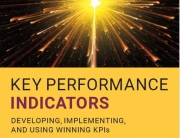KPIs are failing to deliver to their potential. Far too often the measures in an organization amount to a random collection of metrics prepared with little expertise, signifying nothing. David Parmenter explains the common mistakes.
Thinking all performance measures are KPIs
Throughout the world, organizations have been using the term “KPIs” to refer to all performance measures. I believe measures fall into two groups.
Result indicators (RI) are the many measures that summarize combined teamwork but do not help management as it is difficult to pinpoint which teams were responsible. If the RI is an excellent summary of many teams’ cooperation and coordination I call it a Key Result Indicator (KRI) e.g., Return on capital employed and Customer satisfaction.
Performance indicators (PI) can be tied to a team or a cluster of teams working closely together for a common purpose. Good or bad performance is now their responsibility. These measures are about activities and thus are all non-financial. When you put a dollar, yen, pound or euro in front of a measure you have placed a value on an action or event that has taken place. It is the action or event that is the driver. If the PI is profound I call it a Key Performance indicators (KPI) e.g., planes over two hours late.
Not aware of the dark side of every performance measure
Every performance measure, is like the moon, it too will have a dark side, an unintended negative consequence. The importance of understanding this dark side and the careful selection of measures should never be underestimated. Well over half the measures in an organization may be encouraging unintended behavior. As Dean Spitzer says “People will do what management inspects, not necessarily what management expects.”
Lack of linkage between KPIs and the critical success factors (CSFs)
Deriving KPIs is often viewed as an afterthought. These measures are often not tied to anything meaningful. I firmly believe that KPIs exist for a higher purpose — to help align the staff’s daily actions with the organization’s CSFs. The first step in a KPI journey is to ascertain and communicate, the five to eight, organization’s critical success factors to staff. It is the CSFs that should be the origin of all KPIs. I have seen a cartoon of the CSFs, on a A3 sheet, used very successfully to engage staff.
Allowing anybody and everybody to give birth to a measure
There will not be a reader of this article who has not, at some time in the past, been asked to come up with some measures with little or no guidance. I believe the performance measurement process, with your organization, needs a staff member trained who will lead the KPI team and vet all existing measures abandon those that are broken and derive new measures that link to the organisation’s CSFs.
Linking KPIs to pay
It is a myth that the primary driver for staff is money, and that an organization must provide financial incentives to achieve great performance. Recognition, respect and self-actualization are more important drivers. When KPIs are linked to pay, they can create key political indicators (not key performance indicators), which often leads to a manipulation of the measures to enhance the probability of a larger bonus. KPIs that are key to success are too important to be gamed. Performance is expected, or as Jack Welch says “It is a ticket to the game.”









